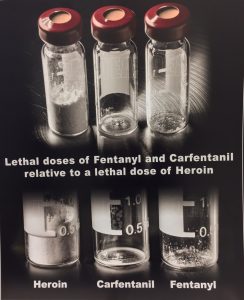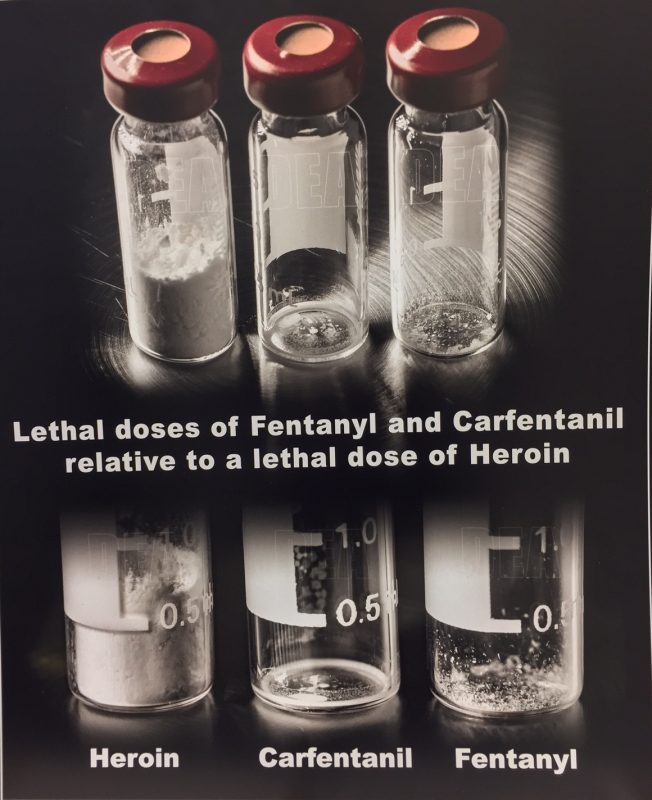 The St. Mary’s County Sheriff’s Office investigated what turned out to be the first death reported in St.Mary’s County due to a powerful opioid that is 5,000 times more powerful than heroin.
The St. Mary’s County Sheriff’s Office investigated what turned out to be the first death reported in St.Mary’s County due to a powerful opioid that is 5,000 times more powerful than heroin.
On June 5th, 2017, police were called to investigate the death of a male subject.
SMNEWSNET contacted the Chief Medical Examiner Office and was informed that “a death on June 5th, 2017 in St. Mary’s County had a positive toxicology report for the substance “Carfentanil” and was the first such finding in St. Mary’s County”.
According to the Drug Enforcement Administration, Carfentanil is a synthetic opioid that is 100 times more potent than fentanyl and 10,000 times more potent than morphine.
As of now, the lethal dose for Carfentanil in humans is unknown.
Not only is this drug dangerous to those who are involved with it, but the DEA warns first responders and medics dealing with this drug to be cautious.
Shawn Davidson, paramedic and Chief of Lexington Park Volunteer Rescue Squad , told SMNEWSNET that, “St. Mary’s County in general and LPVRS in particular are seeing a significant increase in overdoses associated with opiates, as many as 10 in a day. This puts a real strain on the volunteer emergency services in our area. We have also had our first confirmed death associated with Carfentanil, a powerful synthetic opiate that can be absorbed through the skin and is readily inhaled as dust in the air. People need to be aware of the dangers associated with opiate use – particularly the fact that blended substances may make overdose easier and recovery after overdose harder.”
He went on to say “Opiate dependency crosses the entire spectrum of the population. People of all races, socioeconomic status, gender and sexuality regardless of their family background could become addicted to these powerful narcotics. Addiction is a potentially debilitating illness. Our community has resources available to try to help people who struggle with it. Seeking treatment for addiction does not open an individual to potential prosecution, either, which is a common misconception. We are better as a community when we can support those who are trying to shake off their addiction.”
Maryland saw a 66-percent increase in drug and alcohol-related deaths in 2016, Department of Health and Mental Hygiene figure show. More than 1,100 of those deaths were at least in part the result of fentanyl, up from 349 in 2015.
A spokesman for the department said updated numbers for the first quarter of 2017 are expected to be available in about a month.
- Eighty-nine percent of all intoxication deaths that occurred in Maryland in 2016 were opioid-related. Opioid-related deaths include deaths related to heroin, prescription opioids, and nonpharmaceutical fentanyl.
- The number of opioid-related deaths increased by 70% between 2015 and 2016, and has nearly quadrupled since 2010. Non opioid-related drug deaths have also been increasing, but at a slower rate.
- Large increases in the number of heroin and fentanyl-related deaths were largely responsible for the overall rise in opioid-related deaths. Between 2015 and 2016 the number of heroin-related deaths increased by 62% (from 748 to 1212), and the number of fentanyl-related deaths more than tripled (from 340 to 1119). The number of prescription-opioid related deaths increased by 19% (from 351 to 418); many of these deaths occurred in combination with heroin and/or fentanyl.
- The number of heroin-related deaths in Maryland increased five-fold between 2010 and 2016. Heroin deaths have increased among all age groups, Whites and African Americans, men and women, and in all regions of the State.
- Fifty-eight percent of heroin-related deaths in 2016 occurred in combination with fentanyl, 26% in combination with alcohol, 22% in combination with cocaine, and 13% in combination with prescription opioids.
- The number of prescription opioid-related deaths has been rising since 2012, in large part as a result of the use of these drugs in combination with heroin and/or fentanyl. The number of prescription opioid-related deaths has been rising most quickly among the 6 55+ year age group, and falling steadily among individuals below the age of 25. Deaths have been increasing among Whites, African Americans, men, and women.
- Fentanyl-related deaths have been increasing rapidly since 2013. There were an average of 29 deaths per year between 2007 and 2012; the number of deaths increased 38-fold since that time.
- Fentanyl-related deaths have increased substantially among all age groups, among Whites and African Americans, among both men and women, and in all regions of the State.
- Sixty-three percent of fentanyl-related deaths in 2016 occurred in combination with heroin, 26% in combination with alcohol, and 23% in combination with cocaine.



